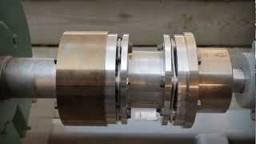Stan Riddle, VibrAlign
Many companies spend a good amount of money and time making sure shaft couplings are aligned correctly. But the actual coupling assembly and maintenance is just as important. If coupling design, assembly, alignment, and maintenance is done properly, a coupling should last for a long time. If done improperly, the machine may not even get up to speed before it fails.
In industrial machinery, the flexible coupling is common. Within that category are many different designs. But most flexible couplings require similar assembly methods.
DESIGN
Just because a coupling will fit on a shaft does not mean it is the right type of coupling. Couplings serve many purposes. They should transmit power from the driver to the driven. They should be rated for the correct horsepower, torque, starting load, and so on. They should also be the weak link between the driver and driven, meaning the coupling element should fail before causing damage to the driving or driven machines. Make sure your coupling is correct for your application. If you don’t know, check with the coupling manufacturer or your engineering department.
HUB TO SHAFT FIT
Follow the manufacturers and machine designers recommendations. Some couplings have a slip fit. Others have an interference fit. But generally speaking, the coupling hub bore should only be slightly larger than the shaft (0.0005-0.0015″ for a slip fit), or slightly smaller than the shaft (0.0005-0.002″ for an interference fit). This fit should not be assumed, but should be measured with micrometers BEFORE attempting to install the hub onto the shaft.
Resist the temptation to drive a coupling on that seems too tight. This often ends in poor axial spacing, or even worse, a broken coupling hub. On the other end of the spectrum, a hub with a fit that is too loose can damage the shaft, overload the key, and if severe enough, can cause the coupling hub to run eccentric to the shaft, increasing vibration and coupling element wear.
SETTING KEYWAYS 180 DEGREES APART
This recommendation has been around for many years. The thought was that if there was any unbalance caused by the key stock, or by machining part of the shaft or hub away for the key seat, that setting the keys 180 degrees out would allow the slight unbalances to counteract each other. If machines are properly balanced, and keys and key seats are cut to proper lengths, then this should not be required. But generally speaking, setting the keys 180 degrees apart doesn’t hurt anything, and it is normally good practice.
AXIAL SPACING
While some coupling types are more sensitive to this than others, axial spacing of the coupling hubs is another important component of coupling assembly. If the hubs are too close, it can cause axial (thrust)loading of the bearings, and a decreased capacity for coupling flexibility. If they are too far apart, it tends to minimize contact between the hub and element, causing increased wear, and the chance of element failure on startup.
Some coupling types, such as disc packs, are especially sensitive to axial spacing. Read and follow the coupling manufacturers recommendations to make sure the spacing is within tolerance.
The shafts of motors with sleeve bearings can move axially during operation, as the rotor finds its magnetic center. Be sure the motor shaft is positioned on its magnetic center before setting the axial spacing.
REPLACING COUPLING ELEMENTS
Whenever possible, replace the coupling element with an element from the hub manufacturer. In addition, make sure to replace the element with one designed for the same horsepower and temperature ranges. Elastomeric elements are different colors for different applications, not just different manufacturers. Just because the elastomer will “fit”, doesn’t mean that it is the right application.
LUBRICATION
There are many good coupling designs which require lubrication. If your couplings are the lubricated type, be sure to follow the coupling manufacturer’s recommendations for the right type of lube. You may need a different lubricant for the coupling than what is used for the bearings.
INSPECTION
Coupling inspection should be an integral part of a machine’s preventive maintenance task. Look for proper lubrication, signs of wear or misalignment, properly tightened set screws, properly seated keys, and so on. If the coupling grease shows signs of hardening, clean the old grease out, and re-lubricate.
Proper design, application, assembly, and maintenance of a coupling is just as critical as any other machine component.





[…] may not elicit the same sort of appreciation as the mechanical equipment they connect, but selection and maintenance of couplings is an important part of maintaining any piece of rotating equipment, including pumping […]